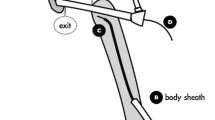Abstract
Purpose
Sheath-type tunnelers are frequently used to create vascular access using vascular grafts. However, during vascular access creation, tunnelers damage the surrounding tissues, consequently causing problems, such as swelling, failure to heal, and infection. This study evaluated a novel rod-type tunneler that was designed to prevent tunneler-related tissue damage and its sequelae.
Methods
We developed a small-diameter rod-type tunneler that reduces injuries during subcutaneous tunnel creation. The rod diameter of this tunneler is smaller than the vascular graft diameter being implanted. It has a structure in which a vascular graft is implanted at a target site by grasping and pulling the vascular graft. Three dogs were used in the experiment, and arteriovenous grafts were created using a rod-type and a sheath-type tunneler on the left and right thighs, respectively, with a different type of commercially available graft used in each dog. The edema of the tissues surrounding the vascular graft was measured at 11 sites by ultrasonography at prespecified intervals.
Results
Compared with implantation using a sheath-type tunneler, when the self-sealing Rapidax II was implanted using the small-diameter rod-type tunneler, the postimplantation edema (degree of change) decreased by 28–53% and 80–247% in the peri-vascular-graft area and within the loop, respectively. The MAXIFLO and SEALPTFE did not significantly reduce postoperative edema but exhibited a tendency for improved postimplantation tissue healing.
Conclusions
The reduced-diameter rod-type tunneler may be a useful device for vascular graft implantation.




Similar content being viewed by others
References
Nitta K, Masakane I, Hanafusa N, Taniguchi M, Hasegawa T, Nakai S, Goto S, Wada A, Hamano T, Hoshino J, Joki N, Abe M, Yamamoto K, Nakamoto H. Japanese Society for Dialysis Therapy Renal Data Registry Committee Annual dialysis data report 2017, JSDT renal data registry. Ren Replace Ther. 2019;5:1–44.
Kukita K, Ohira S, Amano I, Naito H, Azuma N, Ikeda K, Kanno Y, Satou T, Sakai S, Sugimoto T, Takemoto Y, Haruguchi H, Minakuchi J, Miyata A, Murotani N, Hirakata H, Tomo T, Akizawa T. Vascular Access Construction and Repair for Chronic Hemodialysis Guideline Working Group, Japanese Society for Dialysis Therapy 2011 update Japanese Society for Dialysis Therapy Guidelines of vascular access construction and repair for chronic hemodialysis. Ther Apher Dial. 2015;19:1–39.
Schmidli J, Widmer MK, Basile C, de Donato G, Gallieni M, Gibbons CP, Haage P, Hamilton G, Hedin U, Kamper L, Lazarides MK, Lindsey B, Mestres G, Pegoraro M, Roy J, Setacci C, Shemesh D, Tordoir JHM, van Loon M, Committee EG, Kolh P, de Borst GJ, Chakfe N, Debus S, Hinchliffe R, Kakkos S, Koncar I, Lindholt J, Naylor R, Vega de Ceniga M, Vermassen F, Verzini F, Mohaupt M, Ricco JB, Roca-Tey R, Choice—Vascular Access. Clinical Practice Guidelines of the European Society for Vascular Surgery (ESVS). Eur J Vasc Endovasc Surg. 2018;2018:757–818.
Lok CE, Huber TS, Lee T, Shenoy S, Yevzlin AS, Abreo K, Allon M, Asif A, Astor BC, Glickman MH, Graham J, Moist LM, Rajan DK, Roberts C, Vachharajani TJ, Valentini RP. National Kidney Foundation KDOQI clinical practice guideline for vascular access: 2019 Update. Am J Kidney Dis. 2020;75:S1–164.
Ota K, Tsuji Y, Kukita K, Sasaki S, Sakai S, Fuchinoue S, Nakagawa Y, Yamada K, Kanno Y, Hara O, Amano I, Naito N, Tanaka I, Numata A, Minakuchi J, Nakamoto M, Ando T. Feature and clinical use report of Terumo graft for hemodialysis (TRE-687). J Jpn Soc Dial Ther. 2003;36:1693–9.
Kazuno K, Takano Y, Ezaki Y. Development of a new vascular graft for hemodialysis. Jpn J Artif Organs. 2000;29:245–8.
Allen RD, Yuill E, Nankivell BJ, Francis DM. Australian multicentre evaluation of a new polyurethane vascular access graft. Aust N Z J Surg. 1996;66:738–42.
Berry W. Tunneler and method for implanting subcutaneous vascular access grafts. US Patent No. 5306240. 1994. https://patentimages.storage.googleapis.com/73/c6/f0/d83be40d437d67/US5306240.pdfAccessed May 30, 2021.
National Center for Biotechnology Information. PubChem Patent Summary for US-6475244-B2, Tunneling device. https://pubchem.ncbi.nlm.nih.gov/patent/US-6475244-B2. Accessed May 30, 2021.
Haruta N, Tanaka I, Fukuda Y, Kagawa N, Shigeta N, Dohi K. New subcutaneous tunneler for vascular access grafts for hemodialysis. Nihon Toseki Igakkai Zasshi. 1999;32:105–8.
The SCANLAN Vascular Tunneling System. https://www.scanlaninternational.com/products/9009-16/. Accessed 30 May 2021.
Hakaim AG, Scott TE. Durability of early prosthetic dialysis graft cannulation: results of a prospective, nonrandomized clinical trial. J Vasc Surg. 1997;25:1002–5.
Glickman MH, Stokes GK, Ross JR, Schuman ED, SternberghLindberg WCJS, Money SM, Lorber MI. Multicenter evaluation of a polyurethaneurea vascular access graft as compared with the expanded polytetrafluoroethylene vascular access graft in hemodialysis applications. J Vasc Surg. 2001;34:465–72.
Acknowledgements
The author would like to thank Y. Noishiki for technical advice. We would like to thank our colleagues for obtaining the results of this study in 2016. Finally, we are grateful to the referees for their useful comments.
Funding
This research did not receive any specific grant from funding agencies in the public, commercial, or not-for-profit sectors.
Author information
Authors and Affiliations
Contributions
Wrinting, Methodology, Acquisition of data, Formal analysis and investigation: KM, Acquisition and analysis of data: RT, Writing—Reviewing and Editing: HN, Acquisition and analysis of pathological data: HT, Reviewing pathological data as Pathologist: HH, Conceptualization, Investigation: KK.
Corresponding author
Ethics declarations
Conflict of interest
The authors declare that they have no conflict of interest.
Additional information
Publisher's Note
Springer Nature remains neutral with regard to jurisdictional claims in published maps and institutional affiliations.
Rights and permissions
About this article
Cite this article
Maeda, K., Tsuneda, R., Nishida, H. et al. Does a small-diameter rod-type tunneler reduce postoperative swelling? An evaluation using a canine arteriovenous graft model. J Artif Organs 26, 65–72 (2023). https://doi.org/10.1007/s10047-022-01333-4
Received:
Accepted:
Published:
Issue Date:
DOI: https://doi.org/10.1007/s10047-022-01333-4




